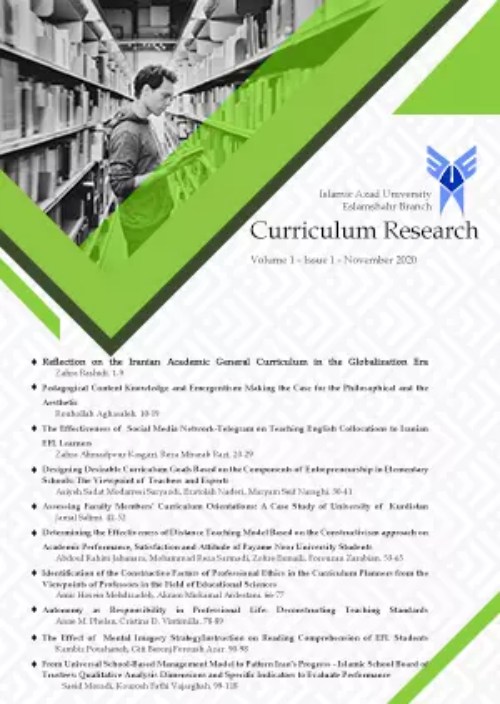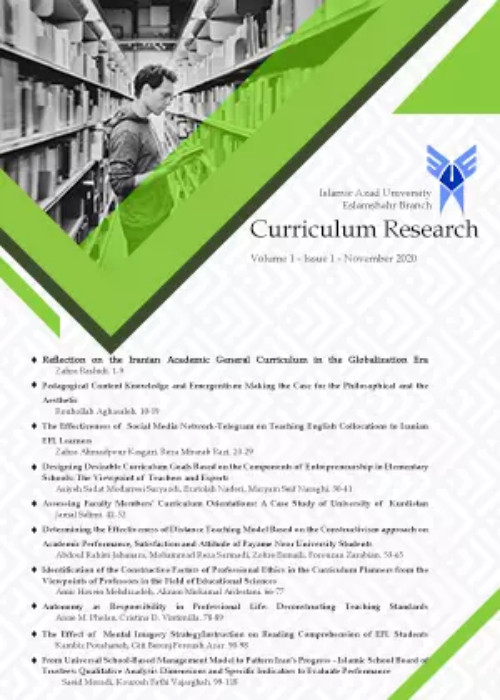فهرست مطالب

Curriculum Research
Volume:3 Issue: 1, Jan 2022
- تاریخ انتشار: 1401/11/24
- تعداد عناوین: 6
-
Pages 1-13PurposeThe present study aimed to design, implement and evaluate a learning situation to achieve the goals of economic education in the third grade of elementary school.MethodologyThis research is applied in terms of purpose and is a quasi-experimental research in terms of method. The research design of this study is a pre-test/post-test design with a control group. The sample of this study were 50 third grade female students of Dr. Hesabi School in District 20 of Rey city who were divided into control and experimental groups. In order to collect data, a researcher-made checklist was used. The validity of the questionnaire was content-face validity and was confirmed by educational planning experts. The reliability of the questionnaire was calculated based on Cronbach's alpha value and was more than 70% and was confirmed. For data analysis, mean and standard deviation indices as well as Kolmogorov–Smirnov test, covariance and SPSS software version 20 were used.FindingsFindings showed that there is a significant difference between students' perceptions of the concepts of economic education in the experimental group and the control group in the pre-test and post-test stages and the designed learning situation has been able to influence third grade students' understanding of the economic concepts of benefit, cost, and consumption. The results show that the average benefit variable in the experimental group post-test was 4.80, the average cost variable in the experimental group post-test was 5.20 and the average consumption variable in the post-test of the experimental group was 9.64.ConclusionAccording to the results, it can be said that the learning situation designed to convey the concept of consumption has been more successful than the other two concepts. This is rooted in the lack of sufficient economic resources appropriate to the student's age group (especially the issue of benefit).Keywords: Economic Education, learning situation, goals of economic education, Benefit, Cost, consumption
-
Pages 14-23There is curious multifaceted neglect regarding the effective use of parents in curriculums before the COVID-19 pandemic and its peak from February 2020 to February 2021 and post-corona virus. This issue hasn't changed despite reports concerning the reluctance of students to go to school and attend face-to-face training. This study aims to explain the current state of schools, that is, the superficial view of the effectiveness of family participation in post-corona virus curriculum. The necessity of parents' participation in the school curriculum is irrefutable. Neglecting this, especially during the COVID-19 pandemic that needs parents' involvement, has made the issue more evident and prominent. In this study, based on research, papers, and documents regarding the involvement of parents in the curricula, the following questions will be surveyed and explained: 1. What are the requirements of parents' involvement in curricula from the point of view of the document? 2. What are the accomplished research requirements regarding parents' involvement in curricula? 3. What are the obstacles to parents' involvement in curricula? 4. What is the position of parents' involvement in curricula? According to the current study's findings, despite the undeniable role of parents' involvement in the effectiveness of curricula, their involvement is the neglected dimension of schools' curricula. In the third year of the COVID-19 pandemic, there is still no coherent plan to use the parents' involvement in virtual training. We will present the critical approaches in the form of proposals in the end.Keywords: parental, involvement, Schools, pedagogical
-
Pages 24-35PurposeThe purpose of this study was to provide a model for managing volunteer forces in the Imam Khomeini Relief Foundation (grounded theory).MethodologyIn the present study, the grounded theory method has been used. The statistical population consisted of experts and professors who were knowledgeable in the field of management and could provide valuable information to the researcher. The research sample was selected through chain sampling method (snowball). Data were collected through 15 semi-structured interviews with professors and experts selected by purposive sampling. The data were analyzed through three stages of open, axial and selective coding.FindingsA model including 5 dimensions, 13 main categories and 41 sub-categories was presented and validated by members' check. Categories are as following: Causal conditions (Having monotheistic faith, having organizational faith, believing in the philosophy of the organization, paying attention to both material and spiritual aspects, having faith and commitment, belief in Velayat-e-Faqih, adhering to revolutionary values, paying attention to Islamic values, paying attention to the value of human relations). Underlying conditions (Respect for members, strengthening self-confidence in the group, strengthening self-confidence in the group, cooperation and team spirit, forming an effective team, division of labor among members, talking to employees, verbal communication, respect for the feelings of others, understanding the position of others). Interfering factors (Determining a clear mission and goal, having a vision, comprehensive knowledge of the organization, problem analysis, quality decision making, prudence and rational decision making, understanding the rules of the organization, the ability to communicate multilaterally, the ability to adjust the rules). Strategies (Develop dynamic methods of recruitment, synergy, training of subordinates, keeping employees up to date, involvement in decisions). Consequences (Retaining the old volunteer forces, attracting new volunteer forces, improving the level of organizational culture, creating a suitable work environment for volunteers, creating a favorable atmosphere in the organization, growing the participatory spirit, growing synergy, growing solidarity). Also, a comprehensive and inclusive model that covers all the contextual, environmental, technical and informational aspects related to the recruitment of volunteers in the Imam Khomeini Relief Foundation was found as a central category.ConclusionIt is necessary to pay attention to the volunteer forces in the Imam Khomeini Relief Foundation, which requires paying attention to issues such as respect for members, team spirit, training subordinates, strengthening organizational culture, creating a favorable organizational atmosphere.Keywords: volunteer forces, Imam Khomeini Relief Foundation, managing model
-
Pages 36-46PurposeLearning is an important factor in life on which the survival and success of organizations depends. The purpose of this survey study is to investigate the causal relationships between the effective factors of participatory learning in primary schools in Bandar Abbas, Iran. The research is applied in terms of purpose.MethodologyThe participants of the study consisted of 35 experts who were selected by purposive sampling. A researcher-made pairwise comparison questionnaire consisting of 5 influential factors of student, teacher, school principal, school atmosphere, and curriculum was used to collect data. The collected data were analyzed by DEMATEL technique.FindingsThe results of the analysis based on ranking showed teacher factor at the top of ranking following with the student factor in the second rank; the third rank belonged to the school atmosphere factor, the curriculum factor was ranked fourth; the principal factor fifth. The results also showed that the teacher factor (R+J=23.91; R-J=0.35) had the most interaction (impact / influence) and then respectively, the student (R+J=23.87; R-J=-0.35), the school atmosphere (R+J=23.85; R-J=1.00), the curriculum (R+J=22.88; R-J=-0.71), and, the principal factors (R+J=22.53; R-J=-0.30) considered the most interacting of all. The school atmosphere (R=12.42) was the most influential factor on the other factors, then the teacher (R=12.13) was the next influential factor, which according to the R-J value of these two influential factors are pure. The most influential factors were the curriculum, the student and the principal, respectively.ConclusionAccording to the results, the content of textbooks should be written and compiled with a special focus on this method of teaching and learning. Also, new determining scales of the correct performance of participatory learning should be developed and used.Keywords: participatory learning, teacher, Curriculum, school atmosphere, student
-
Pages 47-58The present study aimed to shed light on the relationship among students' socioeconomic status, self-reported English proficiency level, the length of attending private institutes, and L2 motivational factors namely: ideal L2 self, ought-to L2 self, L2 learning experience, integrative motivation, and intended effort. Participants were 320 Iranian students studying English at secondary schools in Tehran, the capital city of Iran. Data were collected through closed-ended questionnaire items entailing EFL motivational factors, socioeconomic status, and demographic information. The results of Spearman Rho test revealed weak or no meaningful relationship between the students' socioeconomic status and their L2 motivation suggesting that socioeconomic status is not an indicative of the school students’ EFL motivation regarding tripartite variables of Dörnyei's (2009) L2 Motivational Self System, integrative motivation, and intended effort. However, the length of attending in private language courses and the self-reported English proficiency of the students indicated moderate correlations with their L2 motivation and socioeconomic status. Current findings bear a clear message to the Iranian education policymakers that despite adopting a communicative approach in the latest official English course books, non-official private language institutes still perform more effectively than the Iranian formal education system does in maintaining and enhancing students’ EFL motivation.
-
Pages 59-71
Considering the effectiveness of entrepreneurship training in improving employment and improving the economic level of individuals and communities, there is a great demand for these trainings today. The current research was conducted with the purpose of using the fuzzy Delphi method in the design of the local model of entrepreneurship education. First, using qualitative data obtained from exploratory studies and literature review and interviews conducted in the form of thematic analysis, a number of 60 indicators were compiled in the form of 5 dimensions, 16 components and 60 indicators, and then a questionnaire containing questions in this The questionnaire was compiled and given to 16 selected experts, and in order to check the validity of the results, for the second round, the questionnaires were again sent to the experts. By extracting the most important factors and fitting them through fuzzy Delphi analysis, experts' agreement on common indicators was evaluated. The results showed that four of the items had a score lower than the standard and were removed. Also, the difference between the two stages was lower than the conventional threshold, so the analysis process was stopped. Therefore, it can be said that there is a high agreement on the necessity of the indicators of the mentioned model consisting of five dimensions of individual factors, economic factors, social factors, organizational factors and educational factors.
Keywords: Entrepreneurship, Technical, Vocational Education, Fuzzy Delphi Analysis, Native Model


